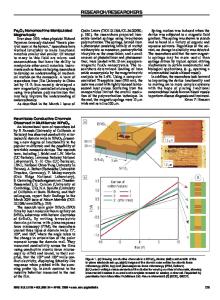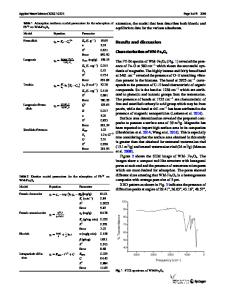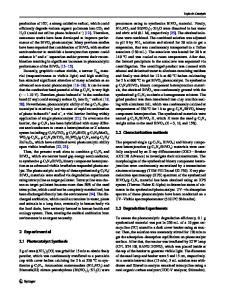Ternary Fe 3 O 4 /MoS 2 /BiVO 4 nanocomposites: novel magnetically separable visible light-driven photocatalyst for effi
- PDF / 4,872,782 Bytes
- 13 Pages / 595.276 x 790.866 pts Page_size
- 39 Downloads / 283 Views
Ternary Fe3O4/MoS2/BiVO4 nanocomposites: novel magnetically separable visible light-driven photocatalyst for efficiently degradation of antibiotic wastewater through p–n heterojunction Jifeng Guo1 · Chaosi Yang1 · Zexin Sun1 · Zhao Yang1 · Liping Wang1 · Changyu Lu1,2 · Zeyang Ma1 · Feng Guo3 Received: 20 May 2020 / Revised: 30 July 2020 / Accepted: 11 August 2020 © Springer Science+Business Media, LLC, part of Springer Nature 2020
Abstract The noble metal-free ternary Fe3O4/MoS2/BiVO4 p–n heterojunctions photocatalyst were prepared via a simply hydrothermal method, which possessed the unique nanospheres-on-microspheres heterostructure. The F e3O4/MoS2/BiVO4 composite photocatalyst exhibited higher photocatalytic degradation of tetracycline hydrochloride (TCH) than those of MoS2, BiVO4 under visible light irradiation (λ > 420 nm). Especially, when the Bi/Mo molar ratio reached 30:1 (FMB3), the FMB3 displayed the highest photocatalytic activity, which can degrade 83% TCH (20 mg/L) within 90 min. The enhanced photocatalytic activity of the ternary photocatalyst could be attributed to the energy band matching and reduction of the charge transfer resistance to promote the spatial separation and reduce the recombination of photogenerated charge carriers due to the formation of built-in electric field by p–n heterojunctions between MoS2 and BiVO4. Additionally, MoS2 can be used as cocatalyst to enhance the separation efficiency of BiVO4 catalyst carrier and thereby improving the photocatalytic activity. Furthermore, the photocatalyst displayed highly stable recycling performances, which can be separated rapidly with an external magnetic field and be reused for five cycles and remain 91.8% of the first time.
1 Introduction
Electronic supplementary material The online version of this article (https://doi.org/10.1007/s10854-020-04230-9) contains supplementary material, which is available to authorized users. * Changyu Lu [email protected] * Feng Guo [email protected] 1
School of Water and Environment, Key Laboratory of Subsurface Hydrology and Ecology in Arid Areas, Ministry of Education, Chang’an University, No. 126 Yanta Road, Xi’an 710054, Shaanxi, People’s Republic of China
2
Hebei Province Key Laboratory of Sustained Utilization & Development of Water Recourse, Hebei Province Collaborative Innovation Center for Sustainable Utilization of Water Resources and Optimization of Industrial Structure, Department of Water Resource and Environment, Hebei Geo University, No. 136 Huai’an Road, Shijiazhuang 050031, Hebei, People’s Republic of China
3
School of Energy and Power Engineering, Jiangsu University of Science and Technology, Zhenjiang 212003, Jiangsu, People’s Republic of China
As one of the greatest inventions of the last century, antibiotics possessing the excellent antibacterial activity have been widely used in treatment of biological disease and promotion of agricultural harvests all over the world [1, 2]. However, the contamination of antibiotic wastewater causes the widespread conce
Data Loading...











